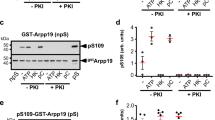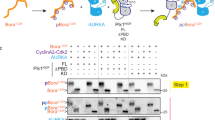Abstract
During mitosis, a select pool of MEK1 and p42/p44 MAPK becomes activated at the kinetochores and spindle poles, without substantial activation of the bulk of the cytoplasmic p42/p44 MAPK. Recently, we set out to identify the MAP kinase kinase kinase (MAPKKK) responsible for this mitotic activation, using cyclin-treated Xenopus egg extracts as a model system, and presented evidence that Mos was the relevant MAPKKK . However, a second MAPKKK distinct from Mos was readily detectable as well. Here, we partially purify this second MAPKKK and identify it as B-Raf. No changes in the activity of B-Raf were detectable during progesterone-induced oocyte maturation, after egg fertilization, or during the early embryonic cell cycle, arguing against a role for B-Raf in the mitotic activation of MEK1 and p42 MAPK. Ras proteins can bring about activation of MEK1 and p42 MAPK in extracts, and Ras may contribute to signaling from the classical progesterone receptor during oocyte maturation and from receptor tyrosine kinases during early embryogenesis. We found that both B-Raf and C-Raf, but not Mos, are required for Ras-induced MEK1 and p42 MAPK activation. These data indicate that two upstream stimuli, active Ras and active Cdc2, utilize different MAPKKKs to activate MEK1 and p42 MAPK.
This is a preview of subscription content, access via your institution
Access options
Subscribe to this journal
Receive 50 print issues and online access
$259.00 per year
only $5.18 per issue
Buy this article
- Purchase on Springer Link
- Instant access to full article PDF
Prices may be subject to local taxes which are calculated during checkout





Similar content being viewed by others
Accession codes
Abbreviations
- ERK:
-
extracellular signal-regulated kinase
- FPLC:
-
fast protein liquid chromatography
- MEK:
-
MAPK kinase or ERK kinase
- MAPK:
-
mitogen-activated protein kinase
- MAPKKK:
-
MAP kinase kinase kinase
- REKS:
-
Ras-activated ERK kinase stimulator
References
Acharya U, Mallabiabarrena A, Acharya JK, Malhotra V . (1998). Cell 92: 183–192.
Alessi DR, Saito Y, Campbell DG, Cohen P, Sithanandam G, Rapp U et al. (1994). Embo J 13: 1610–1619.
Amaya E, Musci TJ, Kirschner MW . (1991). Cell 66: 257–270.
Bagowski CP, Xiong W, Ferreall Jr JE . (2001). J Biol Chem 276: 1459–1465.
Barnier JV, Papin C, Eychene A, Lecoq O, Calothy G . (1995). J Biol Chem 270: 23381–23389.
Barrett CB, Schroetke RM, Van der Hoorn FA, Nordeen SK, Maller JL . (1990). Mol Cell Biol 10: 310–315.
Bayaa M, Booth RA, Sheng Y, Liu XJ . (2000). Proc Natl Acad Sci USA 97: 12607–12612.
Boonyaratanakornkit V, Scott MP, Ribon V, Sherman L, Anderson SM, Maller JL et al. (2001). Mol Cell 8: 269–280.
Catling AD, Reuter CW, Cox ME, Parsons SJ, Weber MJ . (1994). J Biol Chem 269: 30014–30021.
Chong H, Vikis HG, Guan KL . (2003). Cell Signal 15: 463–469.
Colanzi A, Sutterlin C, Malhotra V . (2003). J Cell Biol 161: 27–32.
Davies H, Bignell GR, Cox C, Stephens P, Edkins S, Clegg S . (2002). Nature 417: 949–954.
Eychene A, Dusanter-Fourt I, Barnier JV, Papin C, Charon M, Gisselbrecht S et al. (1995). Oncogene 10: 1159–1165.
Fabian JR, Morrison DK, Daar IO . (1993). J Cell Biol 122: 645–652.
Ferrell Jr JE . (1996a). Curr Top Dev Biol 33: 1–60.
Ferrell Jr JE . (1996b). Trends Biochem Sci 21: 460–466.
Ferrell Jr JE . (1999a). Bioessays 21: 866–870.
Ferrell Jr JE . (1999b). Bioessays 21: 833–842.
Fukuda M, Gotoh Y, Kosako H, Hattori S, Nishida E . (1994). J Biol Chem 269: 33097–33101.
Guadagno TM, Ferrell Jr JE . (1998). Science 282: 1312–1315.
Harland R, Gerhart J . (1997). Annu Rev Cell Dev Biol 13: 611–667.
Hattori S, Fukuda M, Yamashita T, Nakamura S, Gotoh Y, Nishida E . (1992). J Biol Chem 267: 20346–20351.
Itoh T, Kaibuchi K, Masuda T, Yamamoto T, Matsuura Y, Maeda A et al. (1993). Proc Natl Acad Sci USA 90: 975–979.
Jansen HW, Lurz R, Bister K, Bonner TI, Mark GE, Rapp UR . (1984). Nature 307: 281–284.
Kimelman D, Abraham JA, Haaparanta T, Palisi TM, Kirschner MW . (1988). Science 242: 1053–1056.
Kolch W . (2000). Biochem J 351 (Part 2): 289–305.
Lewis TS, Shapiro PS, Ahn NG . (1998). Adv Cancer Res 74: 49–139.
Maller JL . (2003). Science 300: 594–595.
Marais R, Light Y, Paterson HF, Mason CS, Marshall CJ . (1997). J Biol Chem 272: 4378–4383.
Mason CS, Springer CJ, Cooper RG, Superti-Furga G, Marshall CJ, Marais R . (1999). Embo J 18: 2137–2148.
Matsuda S, Gotoh Y, Nishida E . (1993). J Biol Chem 268: 3277–3281.
Minshull J, Sun H, Tonks NK, Murray AW . (1994). Cell 79: 475–486.
Morrison DK, Cutler RE . (1997). Curr Opin Cell Biol 9: 174–179.
Murakami MS, Morrison DK . (2001). Sci STKE 2001: PE30.
Murray AW . (1991). Meth Cell Biol 36: 581–605.
Muslin AJ, MacNicol AM, Williams LT . (1993). Mol Cell Biol 13: 4197–4202.
Nebreda AR, Ferby I . (2000). Curr Opin Cell Biol 12: 666–675.
Newport J, Kirschner M . (1982). Cell 30: 675–686.
Papin C, Denouel-Galy A, Laugier D, Calothy G, Eychene A . (1998). J Biol Chem 273: 24939–24947.
Park JY, Su YQ, Ariga M, Law E, Jin SL, Conti M . (2004). Science 303: 682–684.
Pollock PM, Harper UL, Hansen KS, Yudt LM, Stark M, Robbins CM et al. (2003). Nat Genet 33: 19–20.
Pollock PM, Meltzer PS . (2002). Cancer Cell 2: 5–7.
Pritchard CA, Samuels ML, Bosch E, McMahon M . (1995). Mol Cell Biol 15: 6430–6442.
Rajagopalan H, Bardelli A, Lengauer C, Kinzler KW, Vogelstein B, Velculescu VE . (2002). Nature 418: 934.
Robinson MJ, Cobb MH . (1997). Curr Opin Cell Biol 9: 180–186.
Roy LM, Swenson KI, Walker DH, Gabrielli BG, Li RS, Piwnica-Worms H et al. (1991). J Cell Biol 113: 507–514.
Sadler SE, Maller JL, Gibbs JB . (1990). Mol Cell Biol 10: 1689–1696.
Shapiro PS, Vaisberg E, Hunt AJ, Tolwinski NS, Whalen AM, McIntosh JR et al. (1998). J Cell Biol 142: 1533–1545.
Shibuya EK, Polverino AJ, Chang E, Wigler M, Ruderman JV . (1992). Proc Natl Acad Sci USA 89: 9831–9835.
Shibuya EK, Ruderman JV . (1993). Mol Biol Cell 4: 781–790.
Smythe C, Newport JW . (1991). Meth Cell Biol 35: 449–468.
Sohaskey ML, Ferrell Jr JE . (1999). Mol Biol Cell 10: 3729–3743.
Tian J, Kim S, Heilig E, Ruderman JV . (2000). Proc Natl Acad Sci USA 97: 14358–14363.
VanRenterghem B, Gibbs JB, Maller JL . (1993). J Biol Chem 268: 19935–19938.
Walter SA, Guadagno TM, Ferrell Jr JE . (1997). Mol Biol Cell 8: 2157–2169.
Wan PT, Garnett MJ, Roe SM, Lee S, Niculescu-Duvaz D, Good VM et al. (2004). Cell 116: 855–867.
Wang XM, Yew N, Peloquin JG, Vande Woude GF, Borisy GG . (1994). Proc Natl Acad Sci USA 91: 8329–8333.
Wang XM, Zhai Y, Ferrell Jr JE . (1997). J Cell Biol 137: 433–443.
Widmann C, Gibson S, Jarpe MB, Johnson GL . (1999). Physiol Rev 79: 143–180.
Wu X, Noh SJ, Zhou G, Dixon JE, Guan KL . (1996). J Biol Chem 271: 3265–3271.
Yamamori B, Kuroda S, Shimizu K, Fukui K, Ohtsuka T, Takai Y . (1995). J Biol Chem 270: 11723–11726.
Yew N, Mellini ML, Vande Woude GF . (1992). Nature 355: 649–652.
Yue J, Ferrell Jr JE . (2004). Curr Biol 14: 1581–1586.
Zecevic M, Catling AD, Eblen ST, Renzi L, Hittle JC, Yen TJ et al. (1998). J Cell Biol 142: 1547–1558.
Acknowledgements
We thank R Roth for suggesting the Ras experiments, N Ahn for providing MEK plasmids, J Cooper, J Posada, and R Bhatt for providing p42 MAPK plasmids, and members of the Ferrell lab for helpful discussions and comments on the manuscript. This work was supported by a Grant from the National Institutes of Health (GM46383). JY was supported by a postdoctoral fellowship from the American Heart Association. The sequence of Xenopus B-Raf has been deposited with the NCBI (accession no. AAU29410).
Author information
Authors and Affiliations
Corresponding author
Rights and permissions
About this article
Cite this article
Yue, J., Xiong, W. & Ferrell, J. B-Raf and C-Raf are required for Ras-stimulated p42 MAP kinase activation in Xenopus egg extracts. Oncogene 25, 3307–3315 (2006). https://doi.org/10.1038/sj.onc.1209354
Received:
Revised:
Accepted:
Published:
Issue Date:
DOI: https://doi.org/10.1038/sj.onc.1209354



